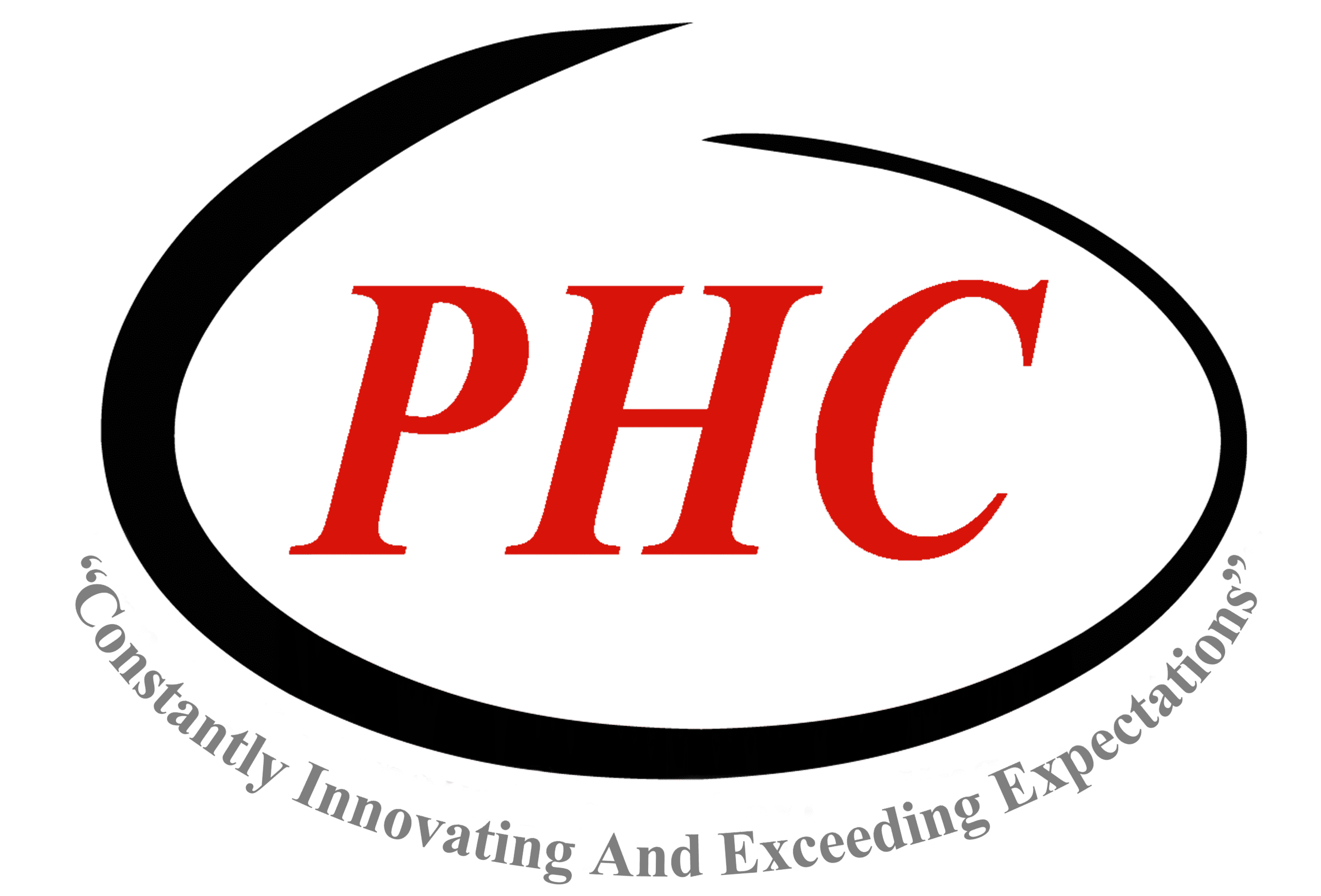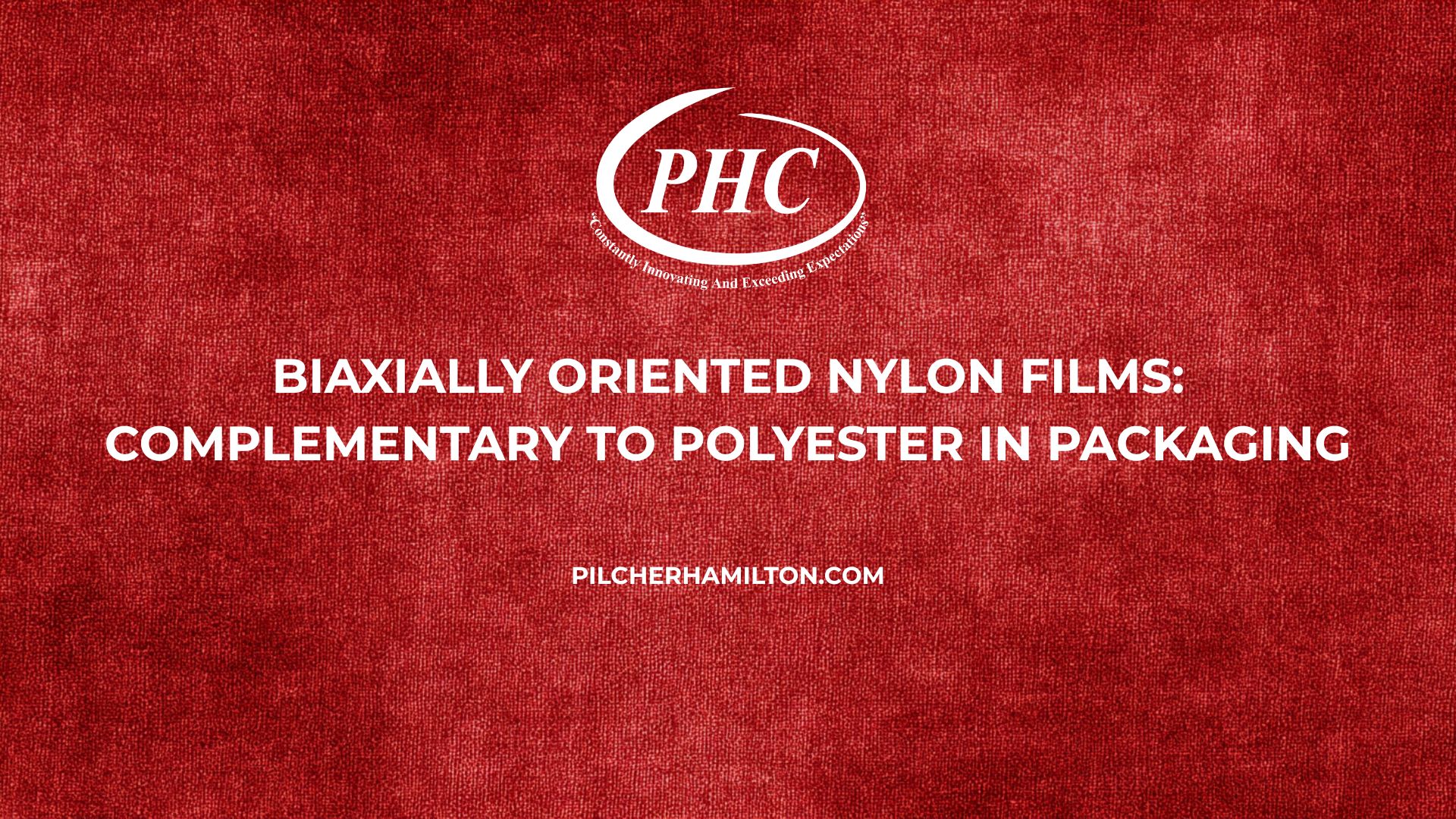Rigid where it must be, tough where it counts, and engineered to run fast—modern flexible packaging often relies on layered laminations, not single materials. Two workhorses dominate: polyester (PET/BOPET) for optical clarity, stiffness, print fidelity, and thermal stability; and biaxially oriented nylon (BON/OPA) for puncture resistance, flex-crack resistance, and oxygen barrier—especially in chilled, vacuum, and abuse-prone applications. If you’re evaluating structures and typing polyester near me to locate a dependable source, this guide explains where BON fits beside PET, how to specify each film, and how Pilcher Hamilton Corporation (PHC) converts and supplies both for U.S. packagers and converters.
Key Takeaways
- BON + PET is a complementary pairing: PET brings stiffness, gloss, print quality, and heat resistance; BON adds toughness, puncture resistance, and oxygen barrier.
- Target specs that matter: Dyne ≥ 38–44 dynes/cm for print/lamination; typical BON gauges 10–25 µm; PET gauges 12–50 µm for packaging webs.
- Barrier realities: BON provides strong O₂ barrier that can vary with humidity; PET offers stable optics and dimensional control with moderate gas barrier.
- Runability counts: COF in the 0.30–0.55 window and tight thickness tolerances keep high-speed lines stable.
- PHC converting: Precision slitting, sheeting, winding, coating, and toll converting deliver press-ready rolls and sheets matched to your line.
BON Films Introduction: What BON Does That PET Doesn’t
Biaxially oriented nylon (BON, also called oriented polyamide / OPA) is stretched in both directions to improve tensile strength and reduce shrinkage. The result is a tough, puncture-resistant film that excels in packs subject to shock, bone-out, edges, or vacuum drawdown—think shredded cheese, jerky, fresh/frozen proteins, or retort- and boil-in-bag constructions.
Where BON shines
- Puncture resistance & flex-crack durability: Helps packages survive handling, shipping, and retail.
- Oxygen barrier: Strong OTR performance in dry-to-moderate conditions supports shelf life for oxidation-sensitive foods.
- Formability: BON conforms well in deep-draw thermoform/vacuum pouches when laminated with appropriate sealants.
What PET brings to the table
- Optical clarity & stiffness: Delivers billboard-quality graphics with excellent layflat for high-resolution print.
- Dimensional stability & heat resistance: Register holds, curling is minimized, and laminations tolerate higher processing temps.
- Surface uniformity: Provides consistent anchor for inks, primers, and adhesives.
For a quick primer on PHC’s nylon offer, see Biax-oriented nylon films. For polyester coverage, browse All Products.
Strength and Barrier Features: BON vs. PET (At-a-Glance)
Below are typical engineering ranges used by converters for specification dialogue. Always verify final values on the exact grade and datasheet you intend to run.
| Property | BON (OPA) – Typical | PET (BOPET) – Typical | Why It Matters |
| Gauge (µm) | 10–25 (40–100 ga) | 12–50 (48–200 ga) | Balances abuse resistance (BON) with stiffness/print (PET) |
| Haze (%) | ≤1.5–3.0 | ≤1.0–1.5 | PET is inherently clearer for high-end graphics |
| Light Transmission (%) | 88–92 | 88–92 | Both suitable for display windows |
| OTR (cc/m²·day, 23 °C) | ~10–40 (humidity dependent) | ~60–120 | BON improves oxygen holdout; PET is moderate |
| WVTR (g/m²·day, 38 °C/90% RH) | ~10–25 | ~3–6 | PET generally lower moisture permeation |
| Tensile MD/TD (MPa) | 120–220 / 120–220 | 180–230 / 180–230 | PET higher modulus → stiffness; BON provides toughness |
| Elongation (%) | 70–150 | 90–140 | BON absorbs abuse; PET favors crisp handling |
| MD/TD Shrink (150 °C) | ≤2.0% | ≤2.0% | Registration stability in laminations |
| Service Temp (°F) | –40 to ~265 | –40 to ~300 | PET offers higher thermal ceiling |
| COF (static/kinetic) | 0.30–0.55 (treated) | 0.30–0.55 (treated) | Line speed stability, stacking, and winding behavior |
Interpretation: If your pack needs toughness + O₂ barrier, BON belongs in the structure. If you need high gloss, print pop, and heat resistance, PET is your A-side print web. Many high-performance structures use BON//PET//sealant (or PET//BON//sealant) with BON on the abuse side.
Pairing with PET in Laminates: Practical Constructions
Common BON–PET architectures (examples; confirm sealant and adhesive for your line):
- BON//PET//PE (or CPP): BON exterior for abuse resistance, PET for stiffness/print, PE (or cast PP) as the heat-seal layer.
- PET//BON//CPP (retort & boil-in-bag): PET print web resists heat; BON improves puncture; CPP seals after sterilization.
- BON//AL//PET (or BON//EVOH//PET): For high barrier, BON is paired with aluminum foil or EVOH barrier, PET supplies dimensional control and print gloss.
- PET//BON//PE/EVOH/PE (multilayer): PET for optics, BON for toughness, EVOH adds moisture-independent O₂ barrier.
For data ranges and print-ready baselines on PET, consult Film Specs and Technical Datasheets. PHC’s Coating team can help dial in primers, acrylics, or release systems if your stack involves PSAs or hard-to-wet inks.
Packaging Solutions Where BON–PET Wins
- Vacuum pouches for meat & cheese: BON tolerates bone-in risk and vacuum draw; PET keeps the front panel crisp for branding.
- Frozen and IQF foods: BON’s toughness survives cold chain; PET ensures a flat, scuff-resistant billboard.
- Retort & boil-in-bag meals: PET’s high-temp stability + BON’s puncture resistance protect product integrity through sterilization.
- Stand-up pouches with windows: PET window clarity, BON body toughness—laminated to polyolefin sealants for drop resistance.
- Abrasive or sharp geometry items (hardware, pet treats): Abuse layer in BON reduces leak failures versus single-film solutions.
For a broader look at PET packaging roles, see Polyester packaging films: top USA applications.
Optical & Surface: Getting Inks and Adhesives to Behave
Surface energy is non-negotiable. Whether BON or PET, target ≥ 40 dynes/cm at the moment of printing/laminating. Both substrates can be corona treated; PET’s treatment tends to be more stable over time, while BON may require tighter handling windows.
- Corona Treatment: Specify arrival dyne and re-treat if stored long or handled heavily. More at Corona-treated PET.
- Functional Coatings: Acrylic and other primers can stabilize dyne, reduce mottle, and improve adhesive wet-out on tough inks or high-speed lamination—see Coating services.
- COF Management: Both films should land between 0.30–0.55 to balance web control and stack release. Over-slick stacks scuff; overly high COF can jam infeed.
Buyer’s Checklist (BON–PET Laminates)
- End Use & Abuse Profile: Vacuum? Bone-in? Drop resistance? Select BON gauge accordingly (10–25 µm).
- Optics vs. Barrier: Prioritize PET for front-panel print clarity; use BON for oxygen barrier + toughness.
- Gauge Stack: PET 12–36 µm for print web; BON 12–20 µm for abuse; adjust to pouch format.
- Dyne Level at Process: Verify ≥ 40 dynes/cm at printing/lamination (not just at receipt).
- Sealant Compatibility: Select PE/CPP layers for target seal initiation (typically 200–260 °F / 93–127 °C depending on resin).
- COF Window: 0.30–0.55 through the full conversion path (print → lam → pouch).
- Barrier Data: Confirm OTR/WVTR at stated RH/temperature for your product (BON is humidity-sensitive).
- Regulatory & Claims: If sustainability is in scope, consider PCR PET in your stack (see Post-consumer recycled).
- Converting Readiness: Core IDs, max OD, splice type, and roll build per your lines—PHC will match.
- Documentation: Pull the Technical Datasheets for the exact grades before trials.
Specification Table (Reference Ranges)
| Parameter | BON (OPA) Target | PET (BOPET) Target | Notes |
| Gauge (µm / mil) | 10–25 / 0.4–1.0 | 12–50 / 0.5–2.0 | Adjust for abuse vs. stiffness |
| Dyne Level (dynes/cm) | 38–44 | 38–44 | Maintain at process point |
| OTR (cc/m²·day, 23 °C) | 10–40 | 60–120 | BON better O₂ barrier |
| WVTR (g/m²·day, 38 °C/90% RH) | 10–25 | 3–6 | PET lower moisture ingress |
| COF (static/kinetic) | 0.30–0.55 | 0.30–0.55 | Line speed & stacking behavior |
| Seal Interface | via lamination | via lamination | Typical seal layer: PE/CPP |
| Operating Temp (°F) | –40 to ~265 | –40 to ~300 | PET higher thermal ceiling |
Need a quick run-down by application? Ask PHC for BON–PET quick picks from our All Services team: slitting, sheeting, winding, and toll converting.
Evolving Standards & Market Direction
- Mono-material momentum: Where possible, brands are pushing mono-PE and mono-PP solutions. BON–PET persists where abuse + barrier + optics require it, or where retort/boil demands exceed single-family options.
- PCR and downgauging: PET layers are candidates for PCR content and gauge optimization; BON down-gauging is common as sealing resins improve.
- Coating innovation: Advanced primers, tie layers, and anti-scuff systems let converters run lower COF without sacrificing print fidelity.
- Data transparency: Expect tighter OTR/WVTR disclosures at multiple RH points; BON’s humidity sensitivity is increasingly modeled in shelf-life tools.
FAQ
Q1: When should I choose BON over PET in a laminate?
Choose BON when puncture resistance, flex-crack durability, and strong oxygen barrier are top priorities—especially for vacuum or abuse-prone packs. Keep PET as the graphic/stiffness layer.
Q2: Does humidity affect BON’s barrier?
Yes. BON’s oxygen barrier can decline as RH rises. If your pack sees high humidity, consider pairing with EVOH or foil, or validate OTR at the relevant RH.
Q3: What dyne level should I specify?
Target ≥ 40 dynes/cm at the point of printing and laminating for both BON and PET. Treatment decay over time is real—verify before each critical step.
Q4: What COF works best on high-speed lines?
A window of 0.30–0.55 is a proven zone for web control without scuffing. PHC can provide coated/tailored surfaces to hit your number.
Q5: Where can I source materials if I’m searching for polyester near me?
PHC supplies PET/BOPET nationwide and supports BON-inclusive laminations via a U.S. converting footprint—helping you spec, test, and scale quickly.
Build Better Laminates with BON + PET
If your next pouch, thermoform, or vacuum pack needs BON toughness without giving up polyester clarity and stability, let PHC help finalize gauges, dyne targets, and COF for production reality. Teams searching for polyester near me can expect responsive engineering support, stocked programs, and precision converting.
Connect with us via Contact PHC and explore our locations. For spec ranges, visit Film Specs.
Pilcher Hamilton Corporation
850 South Buncombe Road
Greer – South carolina🔗 Contact PHC | Locations

